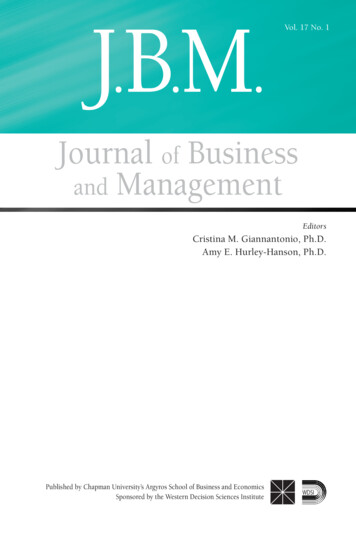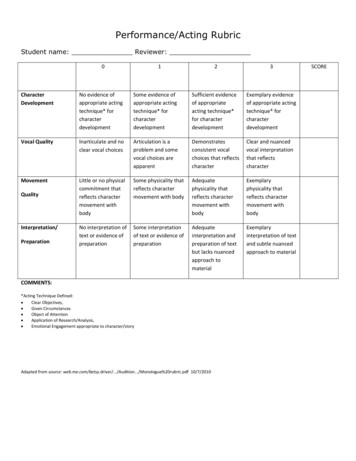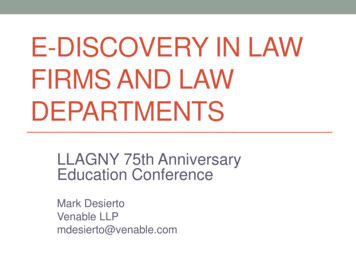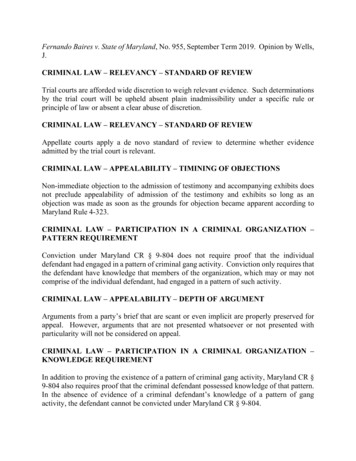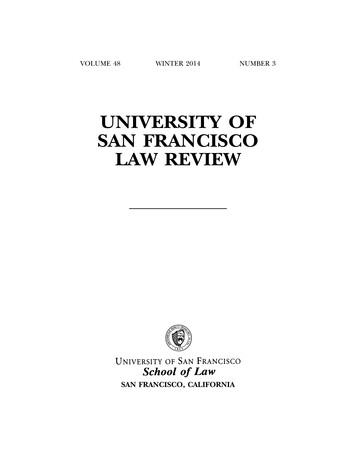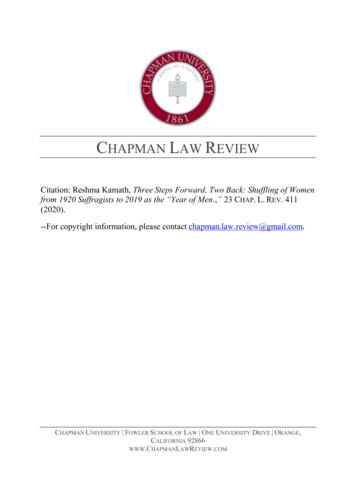
Transcription
CHAPMAN LAW REVIEWCitation: Reshma Kamath, Three Steps Forward, Two Back: Shuffling of Womenfrom 1920 Suffragists to 2019 as the “Year of Men.,” 23 CHAP. L. REV. 411(2020).--For copyright information, please contact chapman.law.review@gmail.com.CHAPMAN UNIVERSITY FOWLER SCHOOL OF LAW ONE UNIVERSITY DRIVE ORANGE,CALIFORNIA 92866WWW.CHAPMANLAWREVIEW.COM
Do Not Delete5/14/20 6:07 PMThree Steps Forward, Two Back: Shuffling ofWomen from 1920 Suffragists to 2019 as the“Year of Men.”Reshma Kamath*I. INTRODUCTION . 412II. 2019 AS THE “YEAR OF MEN”. 414III. WOMEN’S RIGHTS MOVEMENT: A HISTORICAL REVIEW . 416IV. DIFFERENT DOMAINS FOR WOMEN’S ABUSE AND RIGHTS. 418A. Church . 418B. Military . 4221. Advances for Women in Military . 427C. Prison . 4281. Abuse in Prisons and Its Effects . 4292. Women’s Abuse Impacting Mental Health . 431D. Immigrants . 437E. Violence and Homelessness . 437F. Rural Women and Abuse . 439G. Women and Disabilities . 439H. Abortion and Women’s Rights . 440* Reshma Kamath graduated with a Juris Doctor from Northwestern PritzkerSchool of Law, and high honors from Seoul National University’s Graduate ofInternational Studies, specializing in International Cooperation. Here, she won bestgraduate thesis award for her dissertation on corporate-NGO partnerships in emergingand bottom-of-the-pyramid markets. She received an undergraduate degree in Psychologyand Global Studies, graduating Summa Cum Laude, from San José State University. Shetook initiative to venture out to the University of KwaZulu-Natal, Howard Campus inSouth Africa studying international and family law, along with IsiZulu culture andlanguage. Reshma Kamath was a judicial extern with Honorable Judge Marvin E. Aspenof the Northern District of Illinois. She produced the Jamaica Shadow Report incollaboration with the Bluhm Legal International Human Rights Clinic at NorthwesternPritzker School of Law. She was also the Liaison for the Mississippi Center for Justice’sEnvironmental Protection Advocacy Citizen suit for Turkey Creek land development. Shewas an AmeriCorps Peer Leader. In the world of blockchain, she is published in theJournal of Poverty Alleviation and International Development under “Blockchain forWomen: Next Generation for Sustainable Development Goal 5,” and “Crypto-governanceBlockchain Governance for Sustainable Development Goals 16 and 17.”411
Do Not Delete4125/14/20 6:07 PMChapman Law Review[Vol. 23:2V. REVISITING 2019 AS THE “YEAR OF MEN” . 441A. Intersectional Feminism: Triple Constraints ofGender, Race, and Class . 441B. Legislative Progress and Citizen Movement . 442VI. TAKEAWAYS . 444I. INTRODUCTIONMuch to our dismay, American women are as entrenched andsurrounded by patriarchy as are women in other societiesworldwide. Demeaning women’s truths, identities, and rationality isevident throughout American history: from suffragists andabolitionists, to the Anita Hill saga with Clarence Thomas’appointment on the Supreme Court, to Christine Blasey Ford withBrett Kavanaugh-like supporters negating her sound-mindednessas she identified him as the perpetrator, to President Trumpscreaming, “Grab ‘em by the pussy!,”1 or to Southern States callingfor Taliban-style imprisonment for miscarriages.2 Even withchanging modern feminist theory, female voices remain unheardand suppressed. As Eve Ensler from One Billion Rising states,“Three billion women have vaginas, so that’s a lot of women.”3 Also,important to note is “[n]ot every woman has a vagina, or wants tobe defined by [her] vagina.”4With the existence of so many women, it is a naturalprogression for women to speak up on their travails and raise theirexperiences in the conversation. The 1990s were strewn by VaginaMonologues where “women performers recite[d] vulva-centricstories about childbirth and pap smears and masturbation andsexual assault.”5 The #MeToo Movement was an outgrowth ofwomen’s voices being muffled and hushed. In 2017, TIME named,1 Transcript: Donald Trump’s Taped Comments About Women, N.Y. TIMES(Oct. 8, 2016), tape-transcript.html[http://perma.cc/K9MU-v427].2 See generally Grace Panetta, Women could get up to 30 years in prison for having amiscarriage under Georgia’s harsh new abortion law, BUS. INSIDER (May 10, 2019, 9:02 perma.cc/SU4Y-96U6].3 Katherine Gillespie, Do We Still Need 'The Vagina Monologues'?, VICE (Oct. 2,2017, 7:07 PM), http://www.vice.com/en ke [http://perma.cc/T77X-FVXC].4 Id.5 Id.
Do Not Delete2020]5/14/20 6:07 PMThree Steps Forward, Two Back413as Person of the Year, “The Silence Breakers”—those who sharedstories of their sexual assault and harassment.6Even with increased dialogue surrounding rights of women,an overlay of dialogue emphasizing patriarchy exists in America.“Patriarchy says to American women—‘I can protect you fromannihilation. I alone can protect you.’ (Sound familiar? It should.)‘All that you have to [do] is submit to me, and realize that everytime I hurt you, it’s for your own good.’”7 Patriarchal rhetoric isalive and thriving in American culture, society, and politics.Despite momentous, global progress in women’s rights, somecritics claim 2019 as the “Year of Men.”8 The question thenbecomes: have we taken two steps back from the three stepsforward? Are we, as women, shuffling back and forth, in ebbs andflows, with no end in sight? Have we truly progressed on paper,in theory, or are there practical ramifications of women’s suffrageand the #MeToo Movement? What next? Do women need a malefigure to guide them through life when walking on a dark streetor while being in a male-dominated environment? Will tablesturn if women are provided power rivaling that of men?First, this Article introduces the present state of women’srights in light of the #MeToo Movement and 2019 being the “Yearof Men,” in order to demonstrate how change happens at anuneven pace.Second, this Article provides a synopsis of women’s rightsfrom the suffragists and the abolitionist era, to the modern-daydigital movement; more anonymous and where more is often atstake. Are women braver, or more cowardly—hiding behind adigital screen to name men who have harassed them? Are femalesuperiors more apt and sensitive in listening to women andprioritizing their needs? What qualities do we imbibe in ourinstitutions and societies to better accommodate our women, oursisters, and our daughters? How do we unshackle women frompatriarchy rampant in our societies?The subsequent section analyzes women’s rights throughdifferent domains—church, military, prison, immigration,homelessness, ruralism, disability, and abortion. In each domain,6 See Stephanie Zacharek et al., Person of the Year 2017: The Silence Breakers, silence-breakers/ [http://perma.cc/ES69-X6TW](last visited Feb. 19, 2020).7 Umair Haque, Why Do (So Many) American Women Still Support Patriarchy?,EUDAIMONIA & CO. (May 16, 2019), upport-patriarchy-53767f2d7a4 [http://perma.cc/URT9-LSNY].8 Ephrat Livni, There’s a problem at the heart of #MeToo—here’s how to solve it,QUARTZ (Oct. 14, 2018), the-year-ofmen/ [http://perma.cc/6H9F-PFA6].
Do Not Delete4145/14/20 6:07 PMChapman Law Review[Vol. 23:2a common theme is found to be the abuse of women—in whichwomen cope, try to cope, or are told how they should cope, withphysical, mental, emotional, and sexual abuse. Women’sspiraling, vicious cycles of entrapment, leading them to worseplights than they were once in, are evident.The final section of this Article refocuses on the progresspropelled by the #MeToo Movement, and strides we as a society haveto make, to move forward three steps, instead of two steps back.Women’s shuffle for rights has to turn into a movement forward.II. 2019 AS THE “YEAR OF MEN”Change happens—unevenly.In 1991, Clarence Thomas was confirmed to the Supreme Courtdespite testimony from lawyer Anita Hill, who accused Thomas ofsexual harassment before an all-male Senate Judiciary Committee.The [following] year, in 1992, more women ran for political office andwere elected to the Senate than ever before. [This was] dubbed TheYear of the Woman.9The year 2019 has been labeled, “Year of Men,” based on there-emergence of accused men in cultural conversations: fromLouis CK masturbating in the presence of women comics, to AzizAnsari with creepy behavioral issues.10 In 2019, all such menwere back in the limelight with a woe-is-me attitude. Mostshocking is Brett Kavanaugh being sworn in as the 114th Justiceof the United States Supreme Court, even upon the SenateJudiciary Committee’s hearing on sexual assault allegationsagainst the nominee.11 Journalist Connie Chung’s write upencompasses the struggle women face amidst the upheaval of the#MeToo Movement and other women’s rights movements. Whileshe revealed she was molested by her family doctor in college,Connie writes, “Will ‘She Too’ be etched on my tombstoneinstead? I don’t want to tell the truth. I must tell the truth.”12Most women, such as Connie, feel an obligation, an impasseburden, to tell the truth.In the same vein, “none of the men who appear on the ShittyMedia Men List, even those who were accused of multiple countsId.Id.11 See Amy Howe, Kavanaugh confirmed as 114th justice (Updated), SCOTUSBLOG(Oct. 6, 2018, 4:10 PM), med-as114th-justice/ [http://perma.cc/F4SP-8Z6L].12 Connie Chung, Dear Christine Blasey Ford: I, too, was sexually assaulted—andit’s seared into my memory forever, WASH. POST (Oct. 3, 2018, 9:47 49ed3c-c68a-11e89b1c-a90f1daae309 story.html [http://perma.cc/2LHJ-LBUE].910
Do Not Delete2020]5/14/20 6:07 PMThree Steps Forward, Two Back415of rape, have faced criminal charges.”13 The Shitty Men MediaList, a crowdsourced Google spreadsheet, collected allegationsand rumors of sexual misconduct against approximately seventymen in the media industry.14 As an anonymous onlinespreadsheet, the List was a supplement to existing whispernetworks on allegations of sexual harassment and violence in themedia industry.15 Active for twelve hours, the list swiftly wentviral within media circles.16 Reputations of those men, however,preceded them.17 Thus, even with industry-wide commonknowledge, women are yet to see tangible, real, long-lastingimpacts of their actions and speech.What brought the #MeToo Movement to the forefront ofAmerican life was sexual misconduct and rape allegationsagainst Harvey Weinstein.18 In 2006, #MeToo Founder “TaranaBurke, veteran organizer, activist and movement builder,”started her work to help “survivors of sexual violence,particularly Black women and girls, find ways to heal.”19Although Burke appreciates that in 2018 there existed anamazing, global #MeToo platform to talk about sexual violence,to deal with sexual violence, and to galvanize survivors, shewishes the conversation around the movement was different andthat our culture was different.20 Burke wants the #MeTooMovement to focus on those who have labored to step forwardand voice “MeToo.”21 Instead, she sees some in our cultureperceiving the Movement as taking men down, which is not whatis happening, nor was it her intention.13 Constance Grady, The “Shitty Media Men” list, explained, VOX (Jan. 11, 2018, 3:00 F4-KGKK].14 Moira Donegan, I Started the Media Men List: My Name is Moira Donegan, CUT(Jan. 10, 2018), ted-the-media-menlist.html [http://perma.cc/3JYU-QMWY].15 Id.16 Id.17 See id.18 See Tom Hays & Michael R. Sisak, Weinstein rape trial opens, marking milestone for#MeToo, AP NEWS (Jan. 22, 2020), [http://perma.cc/D35A-CY9L].19 “Me Too Movement” turns 2, SUNDANCE (Oct. 18, 2019), ovement-turns-2/ [http://perma.cc/2QFY-7FBG].20 See History & Vision, ME TOO, http://metoomvmt.org/about/ [http://perma.cc/EL2JVRNK] (last visited Feb. 19, 2020); Courtney Connley, #MeToo founder Tarana Burke hasa new hashtag to encourage presidential candidates to address sexual violence, CNBC(Oct. 22, 2019, 10:15 AM), ml [http://perma.cc/6L3G-D7YK].21 See Connley, supra note 20.
Do Not Delete4165/14/20 6:07 PMChapman Law Review[Vol. 23:2As Burke stated, we must listen to untold stories of minoritywomen.22 Minority women who have spoken up and shared theirstories, even prior to the #MeToo Movement, must be lauded. Inher acceptance speech of the Cecil B. DeMille Award for lifetimeachievement at the Golden Globes, Oprah Winfrey mentionedbeing “inspired by all the women who have felt strong enoughand empowered enough to speak up and share their personalstories. . . . But it’s not just a story affecting the entertainmentindustry. It’s one that transcends any culture, geography, race,religion, politics or workplace.”23The #MeToo Movement and the “Year of Men” only representthe most recent efforts to grapple with women’s rights. Thewomen’s rights movement has a long and complex history.III. WOMEN’S RIGHTS MOVEMENT: A HISTORICAL REVIEWAccording to Women and the Constitution, the United StatesConstitution was ordained and established by men in the 1780s.24“[W]omen did not participate in the conventions that framed andratified the Constitution. Women did not vote for conventiondelegates. And women—as women—did not publicly participatein constitutional debates in the press, in pamphlets, and so on.”25The year 1848 marked the women’s suffragist movement, orwoman suffrage;26 the struggle of women to vote and run foroffice. The Seneca Falls convention in New York was thelaunchpad for the women’s rights movement.27 Lack ofgovernmental action pushed a segment of woman suffragists tobecome more militant.28 Thus, prominent female activistsdemanded more. For example, Mary Wollstonecraft declared“war against the patriarchy . . . nothing less than ‘a revolution infemale manners.’”29 This was in no way comparable to dinneretiquette, but “rather sought to overthrow the system of22 ‘Our Pain is Never Prioritized.’ #MeToo Founder Tarana Burke Says We Must Listen to‘Untold’ Stories of Minority Women, TIME (Apr. 23, 2019), -summit/ [http://perma.cc/372Z-TFJC].23 Giovanni Russonello, Read Oprah Winfrey’s Golden Globes Speech, N.Y. TIMES(Jan. 7, 2018), frey-golden-globesspeech-transcript.html [http://perma.cc/EG34-UYRV].24 Akhil Reed Amar, Women and the Constitution, 18 HARV. J.L. & PUB. POL’Y 465,465 (1994).25 Id.26 Seneca Falls Convention, HISTORY (Nov. 20, 2019), -falls-convention [http://perma.cc/H6BX-33KX].27 Id.28 Id.29 Mary Wollstonecraft’s A Vindication of the Rights of Woman (1792), ORDINARYPHILOSOPHY (July 26, 2018), /[http://perma.cc/EX3K-PYDA].
Do Not Delete2020]5/14/20 6:07 PMThree Steps Forward, Two Back417socialisation that made men and women prisoners of each other’styranny . . . .”30 In print, “[s]he targeted literary and intellectualgiants—John Milton, Jean-Jacques Rousseau, Edmund Burke—forpropagating absurd and pernicious ideas about the innateinferiority and natural subordination of women to men.”31The struggle for growing women’s rights also extended intothe literary realm. In abolitionist literature, slave women andgirls iterated graphic accounts of their lives as enslaved women.32The 1856 Republican platform defines slavery and polygamy as “twinrelics of barbarism.” . . . Slave women were breeders against their willas women. They were forced to be wet nurses as women, and sexualplaythings as women. . . . Slave masters intimately associated withslave women. They were the fathers of slave women. They were the(half) brothers of slave women. They were the sexual partners of slavewomen. And sometimes they were more than one of these things atthe same time. They were having sex with their daughters and their(half) sisters.Discourse on these matters featured women, speaking and writingpublicly as women—the Grimke sisters’ and Harriet Martineau’s publiclectures against slavery, Harriet Beecher Stowe’s Uncle Tom’sCabin. . . . In a famous speech, Senator Charles Sumner makes a verysimilar argument, and he’s caned on the floor of the Senate for suggestingthat slave masters are sleeping with their slave women . . . .33The cruelty exposed through the telling of these women’snarratives shed light on the plight of enslaved women during thistime. “[B]lack women refugees suffered tragic losses that wouldhave long-term economic, political, social, and psychologicalconsequences. . . . Black women in refugee camps fought mightilyagainst ideas that rendered them undeserving claimants to thenation’s attention or freedom and citizenship.”34 The abolitionistliterature provided insight into the plight of enslaved women,highlighting the situation of not only white women, but women ofcolor as well.During Reconstruction, women became “agents and thesubjects of the Thirteenth Amendment.”35 Agents, “becausewomen publicly mobilized for the Abolitionist movement.”36Subjects, “because half of the people who were emancipated wereId.Id.32 See Amar, supra note 24, at 466.33 Id. at 466–67.34 Thavolia Glymph, “Invisible Disabilities”: Black Women in War and in Freedom,160 PROC. AM. PHIL. SOC’Y 237, 241 (Sept. 2016).35 Amar, supra note 24, at 467.36 Id.3031
Do Not Delete4185/14/20 6:07 PMChapman Law Review[Vol. 23:2female.”37 Then, the Fourteenth Amendment—the lynchpin ofcivil rights—examined “‘privileges and immunities’ of allcitizens,” native-born men and women, “and ‘equal protection’ ofall persons”; yet designed and defined by the status of“unmarried white women.”38 In effect, it was stating that“America would let [African Americans]—black men and blackwomen—have the rights that unmarried white women” wereentitled to for long enough.39 Lastly, the United StatesConstitution, with the Nineteenth Amendment, restored“symmetry between race and gender . . . [upon] years of hardlabor of a women’s rights crusade . . . about women’s equality.”40The history of women’s rights, particularly of women of color,is a complex and intricate history. (Her) story did not stop withthe passage of the Thirteenth and Fourteenth Amendments. Itcarries on through the present and is seen in various aspects ofour society.The following section discusses different domains forwomen—church, military, prison, immigration, homelessness,ruralism, disability, and abortion—which have seen the battlesand abuses of women and their struggles until this day.IV. DIFFERENT DOMAINS FOR WOMEN’S ABUSE AND RIGHTSA. Church“In February 2019, Pope Francis spoke out against what hedescribed as the ‘sexual slavery’ that nuns all-too-frequentlysuffered at the hands of Catholic priests.”41 This is not a nascentphenomenon, however:Writing in the early 16th century, the Dutch scholar Erasmus alreadylamented that the faithful “often fall into the hands of priests who,under the pretense of confession, commit acts which are not fit to bementioned.” . . . [I]n Spain in 1558, . . . a female penitent of Granadadisclosed to a Jesuit that her confessor was harassing her. . . . For awoman to denounce the offending priest carried serious risks for herhonor and even her life. . . . Jesuit superiors and Pedro Guerrero,archbishop of Granada, decided . . . another confessor could report thecase on the woman’s behalf . . . [which] was strongly contested byId.Id. at 467–68 (emphasis added).Id. at 468–69.40 Id. at 471.41 Wietse De Boer, The Catholic Church and Sexual Abuse, Then and Now, 12ORIGINS (Mar. 2019), ual-abuse-popeconfession-priests-nuns [http://perma.cc/XGM8-WGKE].373839
Do Not Delete2020]5/14/20 6:07 PMThree Steps Forward, Two Back419members of other religious orders, who objected to the inevitablebreach of the secrecy of confession.42“The suspicion that all too often priests abused or seduced theirflock—usually young women—was common in the late MiddleAges. When the Reformation erupted, it became fodder forProtestant critics of the Catholic Church.”43 The abuse andsuppression of women within the domain of the church is notnecessarily a thing of the past. The impacts on women in thereligious realm can take on more indirect forms as well.Do religious, “good” women take more shit? A studypublished in 2002 used:[A] South Carolina sample to describe the perceptions of 199parishioners and 57 battered women attitudes toward whether churchteaching contributes to domestic violence, whether women should besubmissive toward their husbands, and formal services offered bychurches. Different perceptions emerged. More battered womenbelieved church teaching contributed to domestic violence. Neithergroup believed that women should be submissive toward their spouse.44Factors were the “loss of innocence, a period of self-blame,the loss of religious faith, immense pressure to maintain silence,recognition of the imbalance of power, and healing throughoutside help.”45 Some church teachings result in ripple effects onwomen’s plights external to physical religious boundaries.Sexual abuse and church power deem women’s silence to bea sign of submission. A campus life administrator warnedstudents at Divine Child High School in Dearborn, Michigan,during a presentation on dealing with sexual harassment andrape, that “if you dress provocative[ly] . . . and leave absolutelynothing to the imagination younger girls look and go, ‘Oh, mygosh. She’s got plenty of boys around her.’”46 Additionally, theadministrator stated such clothing was contributing to the boys’and mens’ bad behavior and that all the blame is on the girls.47The administrator added, “Those younger guys go, ‘Oh. That’show you talk about women. That’s how you look at women as anobject, something to be dissected.”’48 Another example is aId.Id.44 Ameda A. Manetta et al., The Church—Does it Provide Support for AbusedWomen? Differences in the Perceptions of Battered Women and Parishioners, 5 J. RELIGION& ABUSE 5, 5 (2003).45 See generally Katherine Van Wormer & Lois Berns, The Impact of Priest SexualAbuse: Female Survivors’ Narratives, 19 AFFILIA 53 (2004).46 Zeinab Najm, Female DC students protest sexual harassment lesson, DOWNRIVERSUNDAY TIMES (June 14, 2019), aledc-students-protest-sexual-harassment-lesson/ [http://perma.cc/TZT5-5KYS].47 Id.48 Id.4243
Do Not Delete4205/14/20 6:07 PMChapman Law Review[Vol. 23:2statement made by Mike Shoesmith, a pastor, who said, “‘Menare visually stimulated and unwanted stimulation should meetthe basic definition of assault.’”49 Shoesmith was “asserting thatwomen who dress in a suggestive manner are ‘guilty of indecentvisual assault on a man’s imagination, which does cause mentalanguish and torment.’”50 These perspectives and implicationsabout what values women should adhere to end up impactingwomen at a young age and sticking with them as they grow.In addition to abuse and violence, modern day churchesratify latent attitudes of female inferiority within them; reflectedin church priesthood rankings and female promotions. Whileroughly six in ten American Catholics (59%), in a 2015 PewResearch Center survey, said they support ordaining women intheir church,51 87% of Mormons (including 90% of Mormonwomen) in a 2011 Pew Research Center survey said they do notsupport allowing women to enter the LDS priesthood.52 In asucceeding Mormon survey, in 2016, a study showed youngerMormons far more likely to be troubled by women’s roles in theLDS Church.53Male leaders often act as spiritual coverings for women. Forexample, “preserving a de facto ‘male headship,’ . . . a femaleleader would be required to be in an accountable relationshipwith a male, perhaps her husband or a more seniorminister . . . .”54 Some church boards do not authorize women toexercise formal senior leadership roles but will allow them toexercise other roles.55Again, not a novel phenomenon: within Christianity, theNew Testament has been cited in order to deny women the right49 Kyle Mantyla, Trump-Allied Pastor Carl Gallups Says Women Are SexuallyAssaulting Men By Dressing Provocatively, RIGHT WING WATCH (Oct. 23, 2017, 1:58 lting-men-by-dressing-provocatively/ [http://perma.cc/93M3-MXQN].50 Id.51 See PEW RESEARCH CTR., U.S. CATHOLICS OPEN TO NON-TRADITIONAL FAMILIES 73(Michael Lipka et al. eds., 2015), df [http://perma.cc/KD4D-Q926].52 Id.; see also Aleksandra Sandstrom, Women relatively rare in top positions ofreligious leadership, PEW RESEARCH CTR. (Mar. 2, 2016), eadership/[http://perma.cc/2L7E-GYU3].53 See Jana Riess, Younger Mormons far more likely to be troubled by women’s rolesin the LDS Church, study shows, RELIGION NEWS (Nov. 26, 2018), -the-ldschurch-study-shows/ [http://perma.cc/WRG4-XK48].54 Tanya Riches & Mark Jennings, Explainer: why some churches teach thatwomen are ‘separate but equal’, CONVERSATION (Dec. 21, 2016, 2:01 305 [http://perma.cc/9YKT-ZKTR].55 Id.
Do Not Delete2020]5/14/20 6:07 PMThree Steps Forward, Two Back421to be priests and pastors for much of its history. One of these isfound in 1 Timothy 2:12: “I do not permit a woman to teach or toassume authority over a man; she must be quiet.”56 A differenttext offers evidence that women should not be in leadership rolesin churches and is found in 1 Corinthians 14:34–35:Women are to be silent in the churches. They are not permitted tospeak, but must be in submission, as the Law says. If they wish toinquire about something, they are to ask their own husbands at home;for it is dishonorable for a woman to speak in the church.57Restoring a sense of manliness to men in the church,through “The Emangelization,” Cardinal Raymond Burkedelivered a whopper of a manifesto in an interview.58 Burkeoffered a lengthy meditation on what he perceived to be theproblem with the modern church, beginning with the advent ofthe women’s rights movement during the 1960s for femaleparticipation in the Catholic Church.59 Deriding it as “radicalfeminism,” the “‘goodness and importance of men became veryobscured,’ which gave rise to a ‘very feminized’ Church.”60 He alsodiscusses a period of time “when men who were feminized andconfused about their own sexual identity had entered thepriesthood; sadly some of these disordered men sexually abusedminors; a terrible tragedy for which the Church mourns.”61 “[H]ealso appears rankled by ordinary women doing ordinary Churchactivities,” which, according to him, “constitutes the dangerousfeminization of the Church that has alienated, disenchanted andmade men sexually confused.”62 Manly discipline was his basisfor boys to choose being altar boys.63 Girl servers made youngmen uncomfortable and unwilling to do things with girls.64 Healso, ironically, stated how girls excelled at altar service and howboys drifted away over time.65 This interview demonstrates someof the pre-existing perceptions and expectations regarding girlsand young women.1 Timothy 2:12.1 Corinthians 14:34–35.58 SeeTheNewEmangelizationProject,N EWE D-SR6T] (last visited Dec. 11, 2019).59 Terrence McCoy, Former highest-ranking U.S. cardinal blames ‘feminization’for the Catholic Church’s problems, W ASH. P OST (Jan. 13, 2015, 2:46 roblems[http://perma.cc/W2PC-6DR4].60 Id.61 Id.62 Id.63 Id.64 Id.65 Id.5657
Do Not Delete4225/14/20 6:07 PMChapman Law Review[Vol. 23:2Last, the idea of complementarianism, of separate but equal,i.e., men and women play different, yet “complementary roles inlife, society and . . . religious practice.”66 They “are equal inpersonhood, [yet] they are created for different roles.”67 Althoughseemingly benign facially, the notion of complementarianism hasshackling effects on wo
be defined by [her] vagina.”4 With the existence of so many women, it is a natural progression for women to speak up on their travails and raise their experiences in the conversation. The 1990s were strewn by Vagina Monologues

